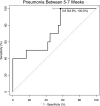Use of Serial Quantitative PCR of the vapA Gene of Rhodococcus equi in Feces for Early Detection of R. equi Pneumonia in Foals
- PMID: 26806422
- PMCID: PMC4913589
- DOI: 10.1111/jvim.13828
Use of Serial Quantitative PCR of the vapA Gene of Rhodococcus equi in Feces for Early Detection of R. equi Pneumonia in Foals
Abstract
Background: Current screening tests for Rhodococcus equi pneumonia in foals lack adequate accuracy for clinical use. Real-time, quantitative PCR (qPCR) for virulent R. equi in feces has not been systematically evaluated as a screening test.
Objective: The objective of this study was to evaluate the accuracy of qPCR for vapA in serially collected fecal samples as a screening test for R. equi pneumonia in foals.
Animals: One hundred and twenty-five foals born in 2011 at a ranch in Texas.
Methods: Fecal samples were collected concurrently with thoracic ultrasonography (TUS) screening examinations at ages 3, 5, and 7 weeks. Affected (pneumonic) foals (n = 25) were matched by age and date-of-birth to unaffected (n = 25) and subclinical (ie, having thoracic TUS lesions but no clinical signs of pneumonia) foals (n = 75). DNA was extracted from feces using commercial kits and concentration of virulent R. equi in feces was determined by qPCR.
Results: Subsequently affected foals had significantly greater concentrations of vapA in feces than foals that did not develop pneumonia (unaffected and subclinical foals) at 5 and 7 weeks of age. Accuracy of fecal qPCR, however, was poor as a screening test to differentiate foals that would develop clinical signs of pneumonia from those that would remain free of clinical signs (including foals with subclinical pulmonary lesions attributed to R. equi) using receiver operating characteristic (ROC) methods.
Conclusions and clinical importance: In the population studied, serial qPCR on feces lacked adequate accuracy as a screening test for clinical R. equi foal pneumonia.
Keywords: Feces; Horse; Pneumonia; Rhodococcus equi.
Copyright © 2016 The Authors. Journal of Veterinary Internal Medicine published by Wiley Periodicals, Inc. on behalf of the American College of Veterinary Internal Medicine.
Figures



Similar articles
-
Estimating the Sensitivity and Specificity of Real-Time Quantitative PCR of Fecal Samples for Diagnosis of Rhodococcus equi Pneumonia in Foals.J Vet Intern Med. 2015 Nov-Dec;29(6):1712-7. doi: 10.1111/jvim.13631. Epub 2015 Oct 5. J Vet Intern Med. 2015. PMID: 26436545 Free PMC article.
-
Validation and evaluation of VapA-specific IgG and IgG subclass enzyme-linked immunosorbent assays (ELISAs) to identify foals with Rhodococcus equi pneumonia.Equine Vet J. 2016 Jan;48(1):103-8. doi: 10.1111/evj.12363. Epub 2015 Jan 25. Equine Vet J. 2016. PMID: 25257622
-
Evaluation of fecal samples from mares as a source of Rhodococcus equi for their foals by use of quantitative bacteriologic culture and colony immunoblot analyses.Am J Vet Res. 2007 Jan;68(1):63-71. doi: 10.2460/ajvr.68.1.63. Am J Vet Res. 2007. PMID: 17199420
-
Rhodococcus equi foal pneumonia.Vet Clin North Am Equine Pract. 2014 Dec;30(3):609-22. doi: 10.1016/j.cveq.2014.08.010. Epub 2014 Oct 3. Vet Clin North Am Equine Pract. 2014. PMID: 25282322 Review.
-
Treatment of Infections Caused by Rhodococcus equi.Vet Clin North Am Equine Pract. 2017 Apr;33(1):67-85. doi: 10.1016/j.cveq.2016.11.002. Epub 2017 Feb 1. Vet Clin North Am Equine Pract. 2017. PMID: 28161038 Review.
Cited by
-
Fecal concentration of Rhodococcus equi determined by quantitative polymerase chain reaction of rectal swab samples to differentiate foals with pneumonia from healthy foals.J Vet Intern Med. 2022 May;36(3):1146-1151. doi: 10.1111/jvim.16438. Epub 2022 Apr 27. J Vet Intern Med. 2022. PMID: 35475581 Free PMC article.
-
Evaluation of oxidative stress in foals with Rhodococcus equi infection-induced pneumonia for the judgment of therapeutic effect.J Vet Med Sci. 2023 Dec 6;85(12):1277-1280. doi: 10.1292/jvms.23-0260. Epub 2023 Oct 17. J Vet Med Sci. 2023. PMID: 37853622 Free PMC article.
-
Current Trends in Understanding and Managing Equine Rhodococcosis.Animals (Basel). 2020 Oct 18;10(10):1910. doi: 10.3390/ani10101910. Animals (Basel). 2020. PMID: 33081047 Free PMC article. Review.
-
Less Typical Courses of Rhodococcus equi Infections in Foals.Vet Sci. 2022 Oct 31;9(11):605. doi: 10.3390/vetsci9110605. Vet Sci. 2022. PMID: 36356082 Free PMC article.
-
Investigation of the relationship between pulmonary lesions based on lung ultrasound and respiratory clinical signs in foals with suspected pulmonary rhodococcosis.Sci Rep. 2023 Nov 8;13(1):19401. doi: 10.1038/s41598-023-46833-2. Sci Rep. 2023. PMID: 37938262 Free PMC article.
References
-
- Giguère S, Cohen ND, Chaffin MK, et al. Rhodococcus equi – clinical manifestations, virulence, and immunity. J Vet Intern Med 2011;25:1221–1230. - PubMed
-
- Giguère S, Cohen ND, Chaffin MK, et al. Diagnosis, treatment, control and prevention of infections caused by Rhodococcus equi in foals. J Vet Intern Med 2011;25:1209–1220. - PubMed
-
- Harrington JR, Golding MC, Martens RJ, et al. Evaluation of RT qPCR for detection and quantitation of virulent R. equi . Am J Vet Res 2005;66:755–761. - PubMed
-
- Monego F, Maboni F, Krewer C, et al. Molecular characterization of Rhodococcus equi from horse‐breeding farms by means of multiplex PCR for the vap gene family. Curr Microbiol 2009;58:399–403. - PubMed
Publication types
MeSH terms
Substances
LinkOut - more resources
Full Text Sources
Other Literature Sources
Medical

